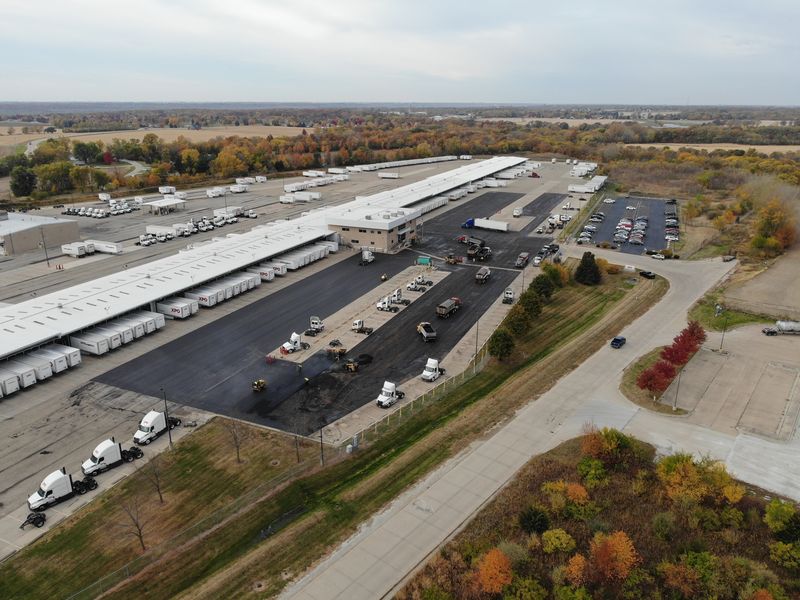Most people walk across a parking lot without giving it a second thought. But every line, crack, or pothole in that asphalt is whispering something about time, weather, and neglect. If you own or manage a commercial property in Pittsburgh, Cleveland, or any of the surrounding areas, your pavement is more than just ground to walk on. It’s the first impression your business makes. The truth is cracked, uneven, or faded asphalt doesn’t just look bad, it screams, “We don’t care about safety.” And you know what? Customers notice. Let’s break down the real signs your commercial asphalt is waving at you before those little imperfections turn into budget-busting disasters requiring extensive repair.
Why Catching Asphalt Problems Early Matters
Think of your asphalt like your car’s engine. If you wait until smoke is pouring out of the hood, repairs cost a fortune. Early detection saves money, boosts safety, and keeps your business looking professional. The Pavement Group has worked with countless property owners across Pennsylvania and Ohio who admitted they wished they had called us sooner. The damage doesn’t stop on its own. It only grows with weather changes, water intrusion, and heavy vehicle traffic.
The 7 Major Signs Your Commercial Asphalt Needs Repair Now
Is your commercial asphalt showing signs of wear and tear? Ignoring these issues can lead to safety hazards, liability risks, and expensive repairs.
1. Cracks That Spread Like Spiderwebs
Tiny surface cracks may not look dangerous but they allow water to seep below the surface. Once the freeze-thaw cycle kicks in, those cracks widen into gaping potholes. If you see interconnected lines forming patterns that look like shattered glass, that’s called alligator cracking. It’s the pavement’s way of waving a red flag and begging for help.
2. Potholes That Swallow Tires
No one likes the sound of a car bouncing into a pothole. Beyond the annoyance, potholes damage vehicles, create trip hazards, and expose your business to liability claims. One deep pothole near a storefront can ruin customer confidence and cause deliveries to avoid your property.
3. Pooling Water After Rain
Standing water on your lot is more than a nuisance. It signals drainage problems or depressions in the asphalt. Water is the enemy of asphalt because it seeps into small cracks and expands during freezing temperatures. If you’re seeing puddles linger long after a storm, it’s time to call The Pavement Group before erosion makes the fix more complicated.
4. Faded Striping and Dull Surface Color
That rich black finish on fresh asphalt doesn’t last forever. Over time, UV rays bleach out the surface and striping becomes nearly invisible. Faded lines confuse drivers, frustrate visitors, and reduce ADA compliance. When the surface turns gray and dusty, it’s more than cosmetic. It’s a sign of oxidation and surface weakening.
5. Uneven Surfaces That Trip People
If your parking lot feels like a mini roller coaster, with bumps and dips everywhere, that’s a structural warning sign. Uneven surfaces happen when the base underneath the asphalt weakens. This can lead to major sub-base repairs if ignored.
6. Loose Gravel and Eroding Edges
Look at the outer edges of your lot. If the asphalt is crumbling away and gravel pieces are showing up, it means the pavement is losing its integrity. Edges are the most vulnerable areas because they have no support from other sections.
7. Oil Stains and Chemical Damage
Those dark stains in parking spots from leaking cars do more than look messy. Gasoline, oil, and chemicals penetrate asphalt and soften its binding materials. Over time, these weakened spots crumble faster than the rest of the lot.
How The Pavement Group Solves Asphalt Problems
The Pavement Group doesn’t just slap a patch on the problem. When it comes to commercial asphalt repair, we provide solutions tailored to the size and severity of the damage. Here’s how we approach it:
Step 1: Inspection and Assessment
We walk the site with you, point out visible damage, and explain hidden risks that you might not see.
Step 2: Recommend the Right Fix
Not every crack needs full replacement. Sometimes sealcoating works, other times milling and resurfacing are necessary.
Step 3: Professional Execution
Our crews use industry-leading equipment and follow local compliance standards for commercial asphalt repair.
Step 4: Long-Term Maintenance Plans
We don’t want to see you again for the same problem next year. That’s why we build maintenance plans to extend pavement life.
Know Your Asphalt’s Condition: Get a FREE Inspection from The Pavement Group!
We’ve been trusted across Pittsburgh, Cleveland, and surrounding regions because we treat every property as if it were our own. From shopping centers to healthcare facilities, we’ve helped business owners protect their investments and keep their properties safe. When you choose us, you’re choosing durability, safety, and peace of mind.
Don’t wait for your lot to become a lawsuit or a money pit. Call The Pavement Group today and schedule a free asphalt inspection. Let us show you exactly what your property needs and how we can make it look brand new again. Safe, smooth, and strong pavement is just one call away.
Frequently Asked Questions
1. What causes asphalt cracks in commercial parking lots?
Asphalt cracks usually come from water seeping into the surface, combined with temperature changes and heavy traffic. Once water gets in, freezing and thawing widen those cracks. Over time, cracks multiply into larger structural issues if not sealed quickly.
2. How dangerous are potholes in commercial asphalt?
Potholes are both safety hazards and financial risks. They can damage vehicles, cause pedestrian injuries, and even lead to lawsuits against property owners. The sooner potholes are repaired, the lower the long-term costs and liabilities.
3. Why does water pooling on asphalt matter?
Pooling water means your lot has drainage problems or low spots. When water sits too long, it breaks down the surface and seeps into cracks. Over time, this leads to more extensive and costly repairs.
4. How can faded striping affect a business?
Faded lines make it hard for drivers to navigate, leading to confusion and unsafe parking. It also reduces ADA compliance and creates a poor first impression for customers. Fresh striping improves safety and professionalism.
5. What does it mean if asphalt edges are crumbling?
Crumbling edges mean the pavement is losing structural support. Without reinforcement, those cracks spread inward and weaken the rest of the lot. Repairing edges early prevents more expensive repairs later.
6. Do oil stains really damage asphalt?
Yes, oil and fuel break down the binding agents in asphalt. Over time, the stained spots soften and deteriorate faster than surrounding areas. Cleaning and sealing those areas early prevents permanent damage.
7. How often should commercial asphalt be inspected?
It’s smart to inspect asphalt at least once a year, ideally after winter. Seasonal changes in Pittsburgh and Cleveland accelerate damage, so annual checks catch issues before they grow.
8. Can sealcoating really extend asphalt life?
Sealcoating acts like sunscreen for asphalt. It protects the surface from UV rays, water, and chemicals. Applied every few years, it can add a decade or more to the pavement’s lifespan.
9. What’s the difference between resurfacing and replacement?
Resurfacing adds a new layer on top of existing asphalt if the base is still solid. Replacement involves removing the entire surface and rebuilding from the ground up. The right choice depends on the severity of damage.
10. When does asphalt need repair?
Asphalt requires repair when you see signs of distress, such as cracking, rutting, or drainage problems. These issues compromise the integrity of the pavement and can create safety hazards.


